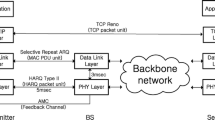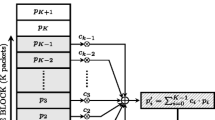Abstract
Providing reliable data communications over wireless channels is a challenging task because time-varying wireless channel characteristics often lead to bit errors. These errors result in loss of IP packets and, consequently, TCP segments encapsulated into these packets. Since TCP cannot distinguish packet losses due to bit corruption from those due to network congestion, any packet loss caused by wireless channel impairments leads to unnecessary execution of the TCP congestion control algorithms and, hence, sub-optimal performance. Automatic Repeat reQuest (ARQ) and Forward Error Correction (FEC) try to improve communication reliability and reduce packet losses by detecting and recovering corrupted bits. Most analytical models that studied the effect of ARQ and FEC on TCP performance assumed that the ARQ scheme is perfectly persistent (i.e., completely reliable), thus a frame is always successfully transmitted irrespective of the number of transmission attempts it takes. In this paper, we develop an analytical cross-layer model for a TCP connection running over a wireless channel with a semi-reliable ARQ scheme, where the amount of transmission attempts is limited by some number. The model allows to evaluate the joint effect of stochastic properties of the wireless channel characteristics and various implementation-specific parameters on TCP performance, which makes it suitable for performance optimization studies. The input parameters include the bit error rate, the value of the normalized autocorrelation function of bit error observations at lag 1, the strength of the FEC code, the persistency of ARQ, the size of protocol data units at different layers, the raw data rate of the wireless channel, and the bottleneck link buffer size.

























Similar content being viewed by others
References
Schulze, H., & Mochalski, K. (2009). Internet study 2008/2009. Resource document. ipoque GmbH. http://www.ipoque.com/study/ipoque-Internet-Study-08-09.pdf. Accessed Nov 10, 2009.
Fairhurst, G., & Wood, L. (2002). IETF RFC 3366: Advice to link designers on link automatic repeat request (ARQ).
Tian, Y., Xu, K., & Ansari, N. (2005). TCP in wireless environments: Problems and solutions. IEEE Communications Magazine, 43(3), S27–S32.
Internet2 NetFlow: weekly reports. (2009). http://netflow.internet2.edu/weekly/. Accessed Nov 10, 2009.
Balakrishnan, H., Padmanabhan, V., Seshan, S., & Katz, R. (1997). A comparison of mechanisms for improving TCP performance over wireless links. IEEE/ACM Transactions on Networking, 5(6), 756–769.
Zorzi, M., Rao, R., & Milstein, L. (1995). Performance analysis of ARQ Go-Back-N protocol in fading mobile radio channels. MILCOM USA, 2(7), 576–580.
Zorzi, M., & Rao, R. (1995). Throughput analysis of Go-Back-N ARQ in Markov channels with unreliable feedback. IEEE ICC USA, 2, 1232–1237.
Zorzi, M., & Rao, R. (1997). ARQ error control for delay-constrained communications on short-range burst-error channels. VTC USA, 3, 1528–1532.
Kim, Y., & Li, S. (1999). Capturing important statistics of a fading/shadowing channel for network performance analysis. IEEE JSAC, 17(5), 888–901.
Zorzi, M., & Rao, R. (1997). The effect of correlated errors on the performance of TCP. IEEE Communication Letters, 1(5), 127–129.
Krunz, M., & Kim, J. (2000). Delay analysis of selective repeat ARQ for a Markovian source over a wireless channel. IEEE Transactions on Vehicular Technology, 49(5), 1968–1981.
Krunz, M., & Kim, J. (2001). Fluid analysis of delay and packet discard performance for QoS support in wireless networks. IEEE JSAC, 19(2), 384–395.
Mukhtar, R., Hanly, S., Zukerman, M., & Cameron, F. (2004). A model for the performance evaluation of packet transmissions using type-II hybrid ARQ over a correlated error channel. Wireless Networks, 10(1), 7–16.
Zhao, J., Li, B., Kok, C., & Ahmad, I. (2004). MPEG-4 video transmission over wireless networks: A link level performance study. Wireless Networks, 10(2), 133–146.
Barman, D., Matta, I., Altman, E., & Azouzi, R. (2004). TCP optimization through FEC, ARQ and transmission power tradeoffs. WWIC, 2957, 87–98.
Barakat, C., & Fawal, A. (2004). Analysis of link-level hybrid FEC/ARQ-SR for wireless links and long-lived TCP traffic. Performance Evaluation Journal, 57(4), 453–476.
Wu, Y., Niu, Z., & Zheng, J. (2005). Cross-layer analysis of wireless TCP/ARQ systems over correlated channels. Journal of Communication and Networks, 7(1), 45–53.
Vacirca, F., Vendictis, A., & Baiocchi, A. (2006). Optimal design of hybrid FEC/ARQ schemes for TCP over wireless links with Rayleigh fading. IEEE Transactions on Mobile Computing, 5(4), 289–302.
Iyer, S., Bhattacharyya, S., Taft, N., & Diot, C. (2003). An approach to alleviate link overload as observed on an IP backbone. IEEE INFOCOM, 1, 406–416.
Medina, A., Allman, M., & Floyd, S. (2005). Measuring the evolution of transport protocol in the Internet. ACM SIGCOMM Computer Communication Review, 35(2), 37–52.
Zorzi, M., Rao, R., & Milstein, L. (1997). ARQ error control for fading mobile radio channels. IEEE Transactions on Vehicular Technology, 46(2), 445–455.
Fantacci, A. (1996). Queuing analysis of the selective repeat automatic repeat request protocol for wireless packet networks. IEEE Transactions on Vehicular Technology, 45(2), 258–264.
Moltchanov, D., Koucheryavy, Y., & Harju, J. (2005). Simple, accurate and computationally efficient wireless channel modeling algorithm. WWIC, 3510, 234–245.
Zhang, Q., & Kassam, S. (1999). Finite-state Markov model for Rayleigh fading channels. IEEE Transactions on Communications, 47(11), 1688–1692.
Konrad, A., Zhao, B., Joseph, A., & Ludwig, R. (2003). Markov-based channel model algorithm for wireless networks. Wireless Networks, 9(3), 189–199.
Moltchanov, D. (2006). State description of wireless channels using change-point statistical tests. WWIC, 3970, 275–286.
Mathis, M., Semke, J., Mahdavi, J., & Ott, T. (1997). The macroscopic behavior of the TCP congestion avoidance algorithm. ACM SIGCOMM Computer Communication Review, 27(3), 67–82.
Padhye, J., Firoiu, V., Towsley, D., & Kurose, J. (2000). Modeling TCP Reno performance: A simple model and its empirical validation. IEEE/ACM Transactions on Networking, 8(2), 133–145.
Moltchanov, D., Dunaytsev, R., & Koucheryavy, Y. (2008). Cross-layer modeling of TCP SACK performance over wireless channels with completely reliable ARQ/FEC. WWIC, 5031, 13–26.
Stallings, W. (2007). Data and computer communications (8th ed.). Englewood Cliffs: Prentice Hall.
Appenzeller, G., Keslassy, I., & McKeown, N. (2004). Sizing router buffers. ACM SIGCOMM Computer Communication Review, 34(4), 281–292.
Allman, M., Paxson, V., & Stevens, W. (1999). IETF RFC 2581: TCP congestion control.
Blanton, E., Allman, M., Fall, K., & Wang, L. (2003). IETF RFC 3517: A conservative selective acknowledgement (SACK)-based loss recovery algorithm for TCP.
Aikat, J., Kaur, J., Smith, F., & Jeffay, K. (2003). Variability in TCP round-trip times. In ACM SIGCOMM internet measurement conference (pp. 279–284).
Shakkottai, S., Srikant, R., Brownlee, N., Broido, A., & Claffy, K. C. (2004). The RTT distribution of TCP flows in the Internet and its impact on TCP-based flow control. CAIDA technical report, TR-2004-02.
(1989). IETF RFC 1122: Requirements for internet hosts—Communication layers.
Wierman, A., Osogami, T., & Olsen, J. (2003). A unified framework for modeling TCP-Vegas, TCP-SACK, and TCP-Reno. MASCOTS, 269–278. doi:10.1109/MASCOT.2003.1240671.
Cardwell, N., Savage, S., & Anderson, T. (2000). Modeling TCP latency. IEEE INFOCOM, 3, 1742–1751.
The network simulator ns-2. http://www.isi.edu/nsnam/ns/.
Paxson, V., & Allman, M. (2000). IETF RFC 2988: Computing TCP’s retransmission timer.




